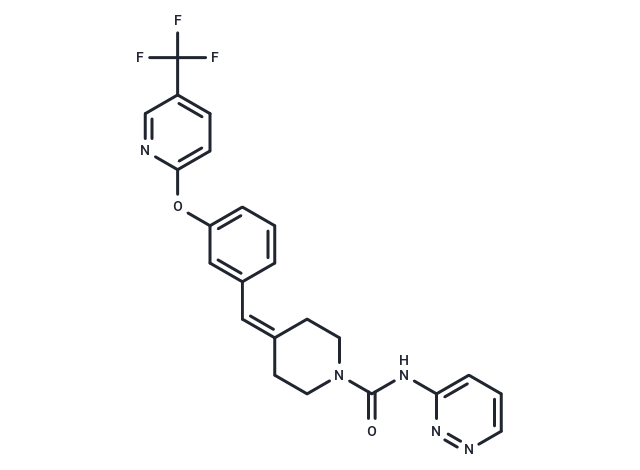Shopping Cart
Remove All Your shopping cart is currently empty
Your shopping cart is currently empty
PF-04457845 is a greatly and effctive FAAH inhibitor, and for hFAAH(IC50=7.2±0.63 nM) and rFAAH(IC50=7.4±0.62 nM).

| Pack Size | Price | USA Warehouse | Global Warehouse | Quantity |
|---|---|---|---|---|
| 2 mg | $30 | In Stock | In Stock | |
| 5 mg | $48 | In Stock | In Stock | |
| 10 mg | $81 | In Stock | In Stock | |
| 25 mg | $166 | In Stock | In Stock | |
| 50 mg | $247 | In Stock | In Stock | |
| 100 mg | $441 | In Stock | In Stock | |
| 200 mg | $573 | In Stock | - | |
| 1 mL x 10 mM (in DMSO) | $53 | In Stock | In Stock |
| Description | PF-04457845 is a greatly and effctive FAAH inhibitor, and for hFAAH(IC50=7.2±0.63 nM) and rFAAH(IC50=7.4±0.62 nM). |
| Targets&IC50 | FAAH (human):7.2±0.63 nM, FAAH (rat):7.4±0.62 nM |
| In vitro | PF-04457845 inhibits FAAH by a covalent, irreversible mechanism involving carbamylation of the active-site serine nucleophile of FAAH with high in vitro potency (kinact/Ki and IC50 values of 40300 M-1s-1 and 7.2 nM, respectively, for human FAAH). |
| In vivo | In a rat model, oral administration of PF-04457845 causes a significant inhibition of mechanical allodynia measured after 4 h with a minimum effective dose (MED) of 0.1 mg/kg. FAAH is confirmed to be completely inhibited in mice treated with PF-04457845(1 and 10 mg/kg p.o.). |
| Kinase Assay | The IC50 values for the inhibition of hFAAH and rFAAH by PF-04457845 is determined. PF-04457845 is preincubated with FAAH for 60 min before initiating the reaction by the addition of the substrate oleamide. Mouse and human tissues are prepared and inhibitor selectivity is assessed by competitive activity-based protein profiling. |
| Cell Research | PF-04457845 is formulated as a nanocrystalline suspension in 2% polyvinylpyrrolidone and 0.15% sodium dodecyl sulfate in H2O (Rats). PF-04457845 is prepared in polyethyleneglycol 300 (Mice).RatsPF-04457845 is administered orally to male Sprague-Dawley rats (200 g-250 g) at the indicated dose (mg/kg) as a nanocrystalline suspension in 2% polyvinylpyrrolidone and 0.15% sodium dodecyl sulfate in H2O. The dose volume is 10 mL/kg. The Paw Withdrawal Threshold (PWT) is evaluated at 4 h post dose. PWT measurements are averaged and statistical comparisons between groups are made using analysis of variance and unpaired T-tests.Mice Male C57BL6/J mice (7 weeks old; n=8) are treated with PF-04457845 (1 or 10 mg/kg in polyethyleneglycol 300 vehicle by oral administration in a volume of 4 mL/kg), the synthetic cannabinoid agonist WIN 55,212-2 (1 or 10 mg/kg in 18:1:1 saline/Emulphor/ethanol vehicle by intraperitoneal administration in a volume of 10 mL/kg), or the corresponding vehicle. Mice are evaluated for hypomotility, hypothermia, antinociceptive, and cataleptic effects at 4 h or 30 min after PF-04457845 or WIN 55,212-2 administration, respectively, using the tetrad tests except that catalepsy is assessed for 60 s instead of 10 s. Statistical analysis is performed using the Student's t test comparing each treatment group with vehicle. |
| Animal Research | Male C57BL6/J mice (7 weeks old) are treated with PF-04457845 (1 or 10 mg/kg in polyethyleneglycol 300 vehicle by oral administration in a volume of 4 mL/kg). |
| Synonyms | PF04457845, PF 04457845 |
| Molecular Weight | 455.43 |
| Formula | C23H20F3N5O2 |
| Cas No. | 1020315-31-4 |
| Smiles | FC(F)(F)c1ccc(Oc2cccc(C=C3CCN(CC3)C(=O)Nc3cccnn3)c2)nc1 |
| Relative Density. | 1.389 g/cm3 (Predicted) |
| Color | White |
| Appearance | Solid |
| Storage | Powder: -20°C for 3 years | In solvent: -80°C for 1 year | Shipping with blue ice/Shipping at ambient temperature. | |||||||||||||||||||||||||||||||||||
| Solubility Information | DMSO: 50 mg/mL (109.79 mM), Sonication is recommended. | |||||||||||||||||||||||||||||||||||
| In Vivo Formulation | 10% DMSO+40% PEG300+5% Tween-80+45% Saline: 2.5 mg/mL (5.49 mM), Sonication is recommeded. Please add the solvents sequentially, clarifying the solution as much as possible before adding the next one. Dissolve by heating and/or sonication if necessary. Working solution is recommended to be prepared and used immediately. The formulation provided above is for reference purposes only. In vivo formulations may vary and should be modified based on specific experimental conditions. | |||||||||||||||||||||||||||||||||||
Solution Preparation Table | ||||||||||||||||||||||||||||||||||||
DMSO
| ||||||||||||||||||||||||||||||||||||
| Size | Quantity | Unit Price | Amount | Operation |
|---|

Copyright © 2015-2025 TargetMol Chemicals Inc. All Rights Reserved.